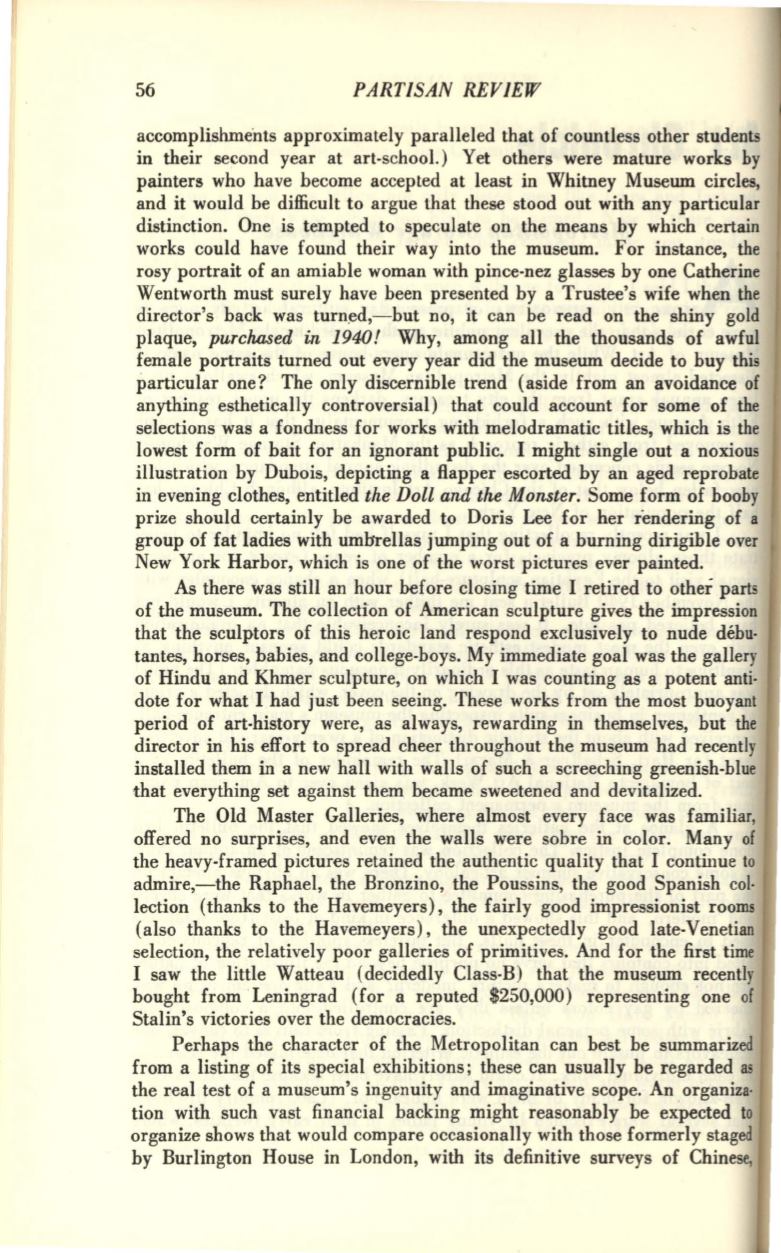
56
PARTISAN REVIEW
accomplishments approximately paralleled that of countless other students
in their second year at art-school.) Yet others were mature works by
painters who have become accepted at least in Whitney Museum circles,
and it would be difficult to argue that these stood out with any particular
distinction. One is tempted to speculate on the means by which certain
works could have found their way into the museum. For instance, the
rosy portrait of an amiable woman with pince-nez glasses by one Catherine
Wentworth must surely have been presented by a Trustee's wife when the
director's back was
turn~d,-but
no, it can be read on the shiny gold
plaque,
purchased in 1940!
Why, among all the thousands of awful
female portraits turned out every year did the museum decide to buy
this
particular one? The only discernible trend (aside from an avoidance of
anything esthetically controversial) that could account for some of the
selections was a fondness for works with melodramatic titles, which is the
lowest form of bait for an ignorant public. I might single out a noxious
illustration by Dubois, depicting a flapper escorted by an aged reprobate
in evening clothes, entitled
the Doll and the Monster.
Some form of booby
prize should certainly be awarded to Doris Lee for her rendering of a
group of fat ladies with umbrellas jumping out of a burning dirigible over
New York Harbor, which is one of the worst pictures ever painted.
As there was still an hour before closing time I retired to other parts
of the museum. The collection of American sculpture gives the impression
that the sculptors of this heroic land respond exclusively to nude debu–
tantes, horses, babies, and college-boys. My immediate goal was the gallery
of Hindu and Khmer sculpture, on which I was counting as a potent anti–
dote for what I had just been seeing. These works from the most buoyant
period of art-history were, as always, rewarding in themselves, but the
director in his effort to spread cheer throughout the museum had recently
installed them in a new hall with walls of such a screeching greenish-blue
that everything set against them became sweetened and devitalized.
The Old Master Galleries, where almost every face was familiar,
offered no surprises, and even the walls were sobre in color. Many of
the heavy-framed pictures retained the authentic quality that I continue to
adrnire,-the Raphael, the Bronzino, the Poussins, the good Spanish col·
lection (thanks to the Havemeyers), the fairly good impressionist rooms
(also thanks to the Havemeyers), the unexpectedly good late-Venetian
selection, the relatively poor galleries of primitives. And for the first time
I saw the little Watteau (decidedly Class-B) that the museum recently
bought from Leningrad (for a reputed $250,000) representing one of
Stalin's victories over the democracies.
Perhaps the character of the Metropolitan can best be summarized
from a listing of its special exhibitions; these can usually be regarded
as
the real test of a museum's ingenuity and imaginative scope. An organiza·
tion with such vast financial backing might reasonably be exJ,ected to
organize shows that would compare occasionally with those formerly staged
by Burlington House in London, with its definitive surveys of Chinese,


